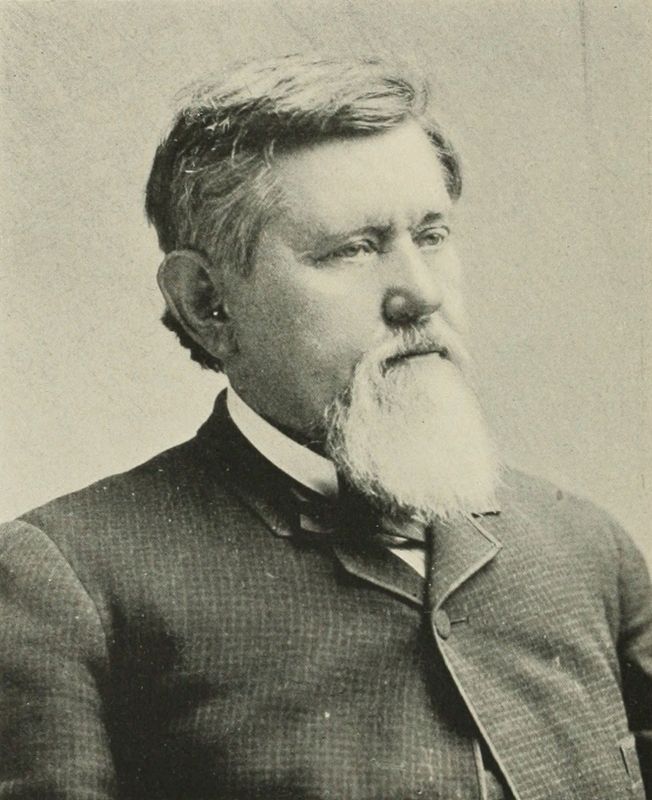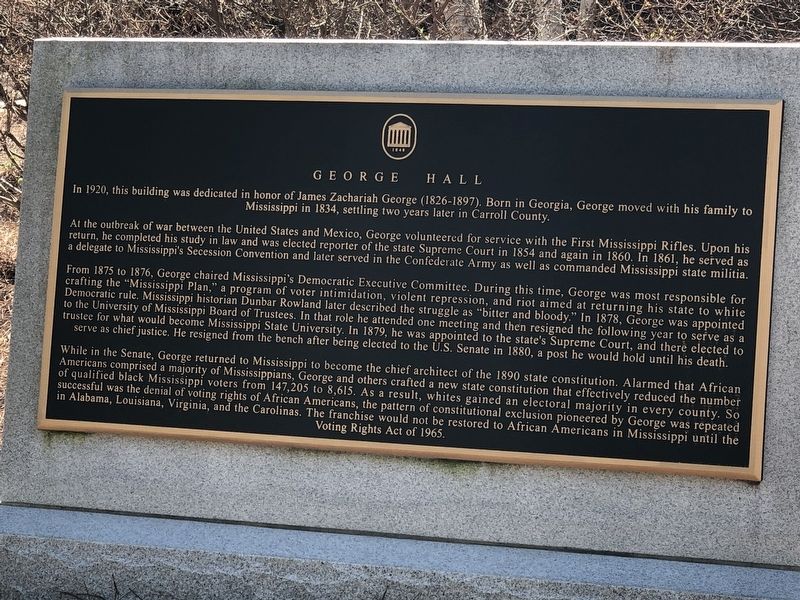University in Lafayette County, Mississippi — The American South (East South Central)
George Hall
At the outbreak of war between the United States and Mexico, George volunteered for service with the First Mississippi Rifles. Upon his return, he completed his study in law and was elected reporter of the state Supreme Court in 1854 and again in 1860. In 1861, he served as a delegate to Mississippi's Secession Convention and later served in the Confederate Army as well as commanded Mississippi state militia.
From 1875 to 1876, George chaired Mississippi's Democratic Executive Committee. During this time, George was most responsible for crafting the “Mississippi Plan,” a program of voter intimidation, violent repression, and riot aimed at returning his state to white Democratic rule. Mississippi historian Dunbar Rowland later described the struggle as “bitter and bloody.” In 1878, George was appointed to the University of Mississippi Board of Trustees. In that role he attended one meeting and then resigned the following year to serve as a trustee for what would become Mississippi State University. In 1879, he was appointed to the state's Supreme Court, and there elected to serve as chief justice. He resigned from the bench after being elected to the U.S. Senate in 1880, a post he would hold until his death.
While in the Senate, George returned to Mississippi to become the chief architect of the 1890 state constitution. Alarmed that African Americans comprised a majority of Mississippians, George and others crafted a new state constitution that effectively reduced the number of qualified black Mississippi voters from 147,205 to 8,615. As a result, whites gained an electoral majority in every county. So successful was the denial of voting rights of African Americans, the pattern of constitutional exclusion pioneered by George was repeated in Alabama, Louisiana, Virginia, and the Carolinas. The franchise would not be restored to African Americans in Mississippi until the Voting Rights Act of 1965.
Erected 2018 by University of Mississippi.
Topics. This historical marker is listed in these topic lists: African Americans • Civil Rights • Government & Politics • War, US Civil. A significant historical year for this entry is 1826.
Location. 34° 22.039′ N, 89° 32.292′ W. Marker is in University, Mississippi, in Lafayette County. Marker is at the intersection of Rebel Drive and Dormitory Row North, on the right when traveling east on Rebel Drive. Touch for map. Marker is at or near this postal address: 352 Rebel Dr, University MS 38677, United States of America. Touch for directions.
Other nearby markers. At least 8 other markers are within walking distance of this marker. Longstreet Hall (about 500 feet away, measured in a direct line); University of Mississippi (about 700 feet away); David Gaffney Sansing, Sr. (approx. 0.2 miles away); Civil Rights Monument (approx. 0.2 miles away); The Lyceum (approx. 0.2 miles away); The Old Chapel (approx. ¼ mile away); The Temple of the Star (approx. ¼ mile away); Lyceum — The Circle Historic District (approx. ¼ mile away). Touch for a list and map of all markers in University.
More about this marker. It is among several plaques the university has installed to provide greater context about its past, particularly in relation to slavery.

Unknown via Internet Archive (Public Domain)
3. James Zachariah George (1826-1897)
During the 1890 Mississippi Constitutional Convention, he led a hardline faction promoting the disenfranchisement of blacks without disenfranchising whites (as opposed to those who wanted to apply property and educational requirements to whites and blacks equally). He later successfully defended the constitution before the Senate and the Supreme Court.
Credits. This page was last revised on April 6, 2023. It was originally submitted on April 6, 2023, by Duane and Tracy Marsteller of Murfreesboro, Tennessee. This page has been viewed 67 times since then and 14 times this year. Photos: 1, 2, 3. submitted on April 6, 2023, by Duane and Tracy Marsteller of Murfreesboro, Tennessee.

